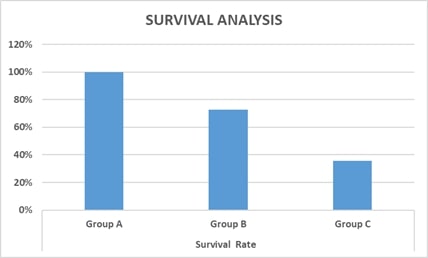Thyroid and Cortisol Changes in Critical Illness

Abstract:
It is known that metabolic and
hormonal reactions that are responses to acute critical illnesses
affect every organ and tissue in the body, however, only little is
understood about the underlying mechanisms. Correction of these hormone
levels as early as possible can lead to reduced stay in hospital and better
prognosis. The present study aims to determine the thyroid and cortisol changes
in acute severely ill patients and to assess their relationship with the severity
of illness. The present prospective observational study was conducted in sixty
critically ill patients grouped according to APACHE II score. The baseline
characters that were used to calculate the APACHE II score were 1. Temperature,
2, heart rate, 3 hematocrit, 4 sodium levels, 5 potassium levels, 6 WBC count
7, pH, 8 pO2 10 respiratory rates 11 GCS. Blood samples were collected from
patients at 1 and 8 days of admission by aseptic venipuncture. The samples were
processed and levels of FT3, FT4, TSH and cortisol levels were assessed using
standard protocol. The obtained data were recorded and subjected to statistical
analysis. Groups were compared using one-way ANOVA with post hoc Tukey
HSD. Comparison among groups was done
student t-Test method. Pearson chi-square test or Fisher exact test (2-tailed)
was used to compare proportions. The p-value less than 0.05 was considered
significant. The results showed the normal values of various parameters in the
3 groups and will serve as a reference for the Indian population.
References:
[1]. Economidou,
F., Douka, E., Tzanela, M., Nanas, S., Kotanidou, A., 2002, Thyroid function
during critical illness. Hormones (Athens),10(2), 117-24, doi:
10.14310/horm.2002.1301.
[2]. Maiden,
M. J., Torpy, D. J., 2009, Thyroid Hormones in Critical Illness. Crit Care
Clin., 35(2), 375-388, doi: 10.1016/j.ccc.2018.11.012.
[3]. Téblick,
A., Gunst, J., Van den Berghe, G., 2002, Critical Illness-induced
Corticosteroid Insufficiency: What It Is Not and What It Could Be. J Clin
Endocrinol Metab., 107(7), 2057-2064. doi: 10.1210/clinem/dgac201.
[4]. Hermans,
G., Van Aerde, N., Meersseman, P., Van Mechelen, H., Debaveye, Y., Wilmer, A.,
Gunst, J., Casaer, M. P., Dubois, J., Wouters, P., Gosselink, R., Van den
Berghe, G., 2009, Five-year mortality and morbidity impact of prolonged versus
brief ICU stay: a propensity score matched cohort study. Thorax,
74(11),1037-1045, doi: 10.1136/thoraxjnl-2018-213020.
[5]. Van
Aerde, N., Meersseman, P., Debaveye, Y., Wilmer, A., Gunst, J., Casaer, M. P.,
Wauters, J., Wouters, P. J., Gosselink, R., Van den Berghe, G., Hermans, G.,
2021, Five-year outcome of respiratory muscle weakness at intensive care unit
discharge: Secondary analysis of a prospective cohort study,76(6), 561-567.
doi: 10.1136/thoraxjnl-2020-216720.
[6]. Tian,
Y., Yao, Y., Zhou, J., Diao, X., Chen, H., Cai, K., Ma, X., Wang, S., 2022,
Dynamic APACHE II Score to Predict the Outcome of Intensive Care Unit Patients.
Front Med (Lausanne), 26(8), 744907. doi: 10.3389/fmed.2021.744907.
[7]. Schectman,
J. M., Kallenberg, G. A., Hirsch, R. P., Shumacher, R. J., 1991, Report of an
association between race and thyroid stimulating hormone level. Am J Public
Health. 81(4), 505-6. doi: 10.2105/ajph.81.4.505.
[8]. Malinowski,
J. R., Denny, J. C., Bielinski, S. J., Basford, M. A., Bradford, Y., Peissig.
P. L., et al., 2014, Genetic variants associated with serum thyroid stimulating
hormone (TSH) levels in European Americans and African Americans from the
eMERGE Network. PLoS One, 9(12), e111301. doi:
10.1371/journal.pone.0111301.
[9]. Hollowell,
J. G., Staehling, N. W., Flanders, W. D., Hannon, W. H., Gunter, E. W.,
Spencer, C. A., Braverman, L. E., Serum, T. S. H., 2002, T (4), and thyroid
antibodies in the United States population (1988 to 1994): National Health and
Nutrition Examination Survey (NHANES III). J Clin Endocrinol Metab,
87(2), 489-99. doi: 10.1210/jcem.87.2.8182.
[10]. Deer,
L. K., Shields, G. S., Ivory, S. L., Hostinar, C. E., Telzer, E. H., 2018,
Racial/ethnic disparities in cortisol diurnal patterns and affect in
adolescence. Dev Psychopathol, 30(5),1977-1993, doi:
10.1017/S0954579418001098.
[11]. Van den Berghe G., 2001,
The neuroendocrine response to stress is a dynamic process. Best Practice
& Research. Clinical Endocrinology & Metabolism, 15(4),
405–419. https://doi.org/10.1053/beem.2001.0160
[12]. Marx, C., Petros,
S., Bornstein, S. R., Weise, M., Wendt, M., Menschikowski, M., Engelmann, L.,
& Höffken, G., 2003, Adrenocortical hormones in survivors and nonsurvivors
of severe sepsis: diverse time course of dehydroepiandrosterone,
dehydroepiandrosterone-sulfate, and cortisol. Critical Care Medicine, 31(5),
1382–1388. https://doi.org/10.1097/01.CCM.0000063282.83188.3D
[13]. Schuetz, P.,
Müller, B., Nusbaumer, C., Wieland, M., & Christ-Crain, M., 2009,
Circulating levels of GH predict mortality and complement prognostic scores in
critically ill medical patients. European Journal of Endocrinology, 160(2),
157–163. https://doi.org/10.1530/EJE-08-0786
[14]. Slag, M. F.,
Morley, J. E., Elson, M. K., Crowson, T. W., Nuttall, F. Q., & Shafer, R.
B., 1981, Hypothyroxinemia in critically ill patients as a predictor of high
mortality. JAMA, 245(1), 43–45.
[15]. Rothwell, P. M.,
& Lawler, P. G., 1995, Prediction of outcome in intensive care patients
using endocrine parameters. Critical Care Medicine, 23(1),
78–83. https://doi.org/10.1097/00003246-199501000-00015
[16]. Rothwell, P. M.,
Udwadia, Z. F., & Lawler, P. G., 1993, Thyrotropin concentration predicts
outcome in critical illness. Anaesthesia, 48(5),
373–376. https://doi.org/10.1111/j.1365-2044.1993.tb07006.x
[17]. Yapps,
B., Shin, S., Bighamian, R., Thorsen, J., Arsenault, C., Quraishi, S. A., Hahn,
J, O., 2017, Reisner AT. Hypotension in ICU Patients Receiving Vasopressor
Therapy. Sci Rep.,7(1), 8551, doi: 10.1038/s41598-017-08137-0.
[18]. Zhou,
Y., Zheng, M. H., Chen, C. S., Sun, D. Q., Chen, X. X., Sun, M., Wang, Y. H.,
Liu, Y., Pan, J. Y., Zheng, C. F., 2019, Prognostic value of hematocrit levels
among critically ill patients with acute kidney injury. European Journal of
Inflammation. 17. doi:10.1177/2058739219846820
[19]. Padhi,
R., Panda, B. N., Jagati, S., Patra, S. C., 2014, Hyponatremia in critically
ill patients. Indian J Crit Care Med,18(2):83-7. doi:
10.4103/0972-5229.126077.
[20]. Tongyoo,
S., Viarasilpa, T., Permpikul, C., 2018, Serum potassium levels and outcomes in
critically ill patients in the medical intensive care unit. J Int Med Res.,
46(3):1254-1262, doi: 10.1177/0300060517744427.
[21]. Rimmer,
E., Garland, A., Kumar, A., Doucette, S., Houston, B. L., Menard, C. E.,
Leeies, M., Turgeon, A. F., Mahmud, S., Houston, D. S., Zarychanski, R., 2022,
White blood cell count trajectory and mortality in septic shock: a historical
cohort study. Can J Anaesth, 69(10),1230-1239. doi:
10.1007/s12630-022-02282-5.
[22]. Prowle,
J. R., Kolic, I., Purdell Lewis, J., Taylor, R., Pearse, R. M., Kirwan, C. J.,
2014, Serum creatinine changes associated with critical illness and detection
of persistent renal dysfunction after AKI. Clin J Am Soc Nephrol, 9(6),
1015-23, doi: 10.2215/CJN.11141113.
[23]. Samanta,
S., Singh, R.K., Baronia, A. K., Mishra, P., Poddar, B., Azim, A., Gurjar, M.,
2018, Early pH Change Predicts Intensive Care Unit Mortality. Indian J Crit
Care Med., 22(10), 697-705, doi: 10.4103/ijccm.IJCCM_129_18.
[24]. Demiselle,
J., Calzia, E., Hartmann, C., Messerer, D. A. C., Asfar, P., Radermacher, P.,
Datzmann, T., 2021, Target arterial PO2 according to the underlying pathology:
a mini-review of the available data in mechanically ventilated patients. Ann
Intensive Care,11(1), 88. doi: 10.1186/s13613-021-00872-y.
[25]. Garrido,
D., Assioun, J. J., Keshishyan, A., Sanchez Gonzalez., M. A., Goubran, B.,
2018, Respiratory Rate Variability as a Prognostic Factor in Hospitalized
Patients Transferred to the Intensive Care Unit. Cureus, 10(1), e2100.
doi: 10.7759/cureus.2100.
[26]. Fathi,
M., Moghaddam, N. M., Jame, S. Z., Darvishi, M., Mortazavi, M., 2002, The
association of Glasgow Coma Scale score with characteristics of patients
admitted to the intensive care unit. Informatics in Medicine Unlocked,
29,100904. doi: 10.1016/j.imu.2022.100904
[27]. Gutch,
M., Kumar, S., Gupta, K. K., 2018, Prognostic Value of Thyroid Profile in
Critical Care Condition. Indian J Endocrinol Metab, 22(3), 387-391. doi:
10.4103/ijem.IJEM_20_18.
[28]. Wang,
F., Pan, W., Wang, H., Wang, S., Pan, S., Ge, J., 2012, Relationship between
thyroid function and ICU mortality: a prospective observation study. Crit
Care,16(1), R11, doi: 10.1186/cc11151.
[29]. Hamrahian,
A. H., Oseni, T. S., Arafah, B. M., 2004, Measurements of serum free cortisol
in critically ill patients. N Engl J Med, 350(16), 629-38, doi:
10.1056/NEJMoa020266.

